|

|
WDM. ASIO. VST, DirectX, MFX, and ReWire: Thanks to Project5's open architecture, you're not limited in your choice of instruments, effects, or hardware, but did you know that you're no less limited when it comes to playing and controlling these instruments or effects in real-time? Project5 gives you all of the real-time, hands-on control of hardware, combined with the power and ease of software.
In this tutorial, we'll show you how to customize Project5; taking control of instruments, effects, and track parameters with your MIDI keyboard or controller. You can edit synth parameters with knobs and sliders, play different instruments simultaneously from one or more keyboards and trigger whole MIDI and Audio phrases in-sync and on the fly. This kind of control can make it easy to translate complex projects into a live performance, but they also increase the fun factor whether you're on stage or in the studio. Let's find out how...
|
|

|
 Setting Up Keyboard Splits Setting Up Keyboard Splits
These days, many people have eschewed multiple keyboards, preferring the flexibility of a software instrument and a single controller keyboard. Of course, this might lead to some head scratching when you want to control multiple instruments at once. In this lesson, we'll show you how to do this and much more.
Start a new file in Project5. To give yourself more space, hide the Pattern Sequencer by pressing Alt-1 or choose 'Performance' from the View Menu. Next set the tempo to 110 BPM.
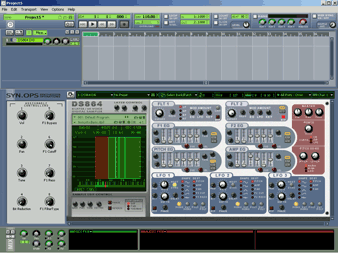
The 'Performance' View
|
|

|
We'll begin by adding several different instruments. Add an instance of DS864. By default a Rhodes will be loaded. Replace this with a bass by clicking on the 'Open Program' button on the second row and then select the AcousticBass.DP8 file from either the 2nd Project5 disk or from your hard drive (if you copied it from the CD).
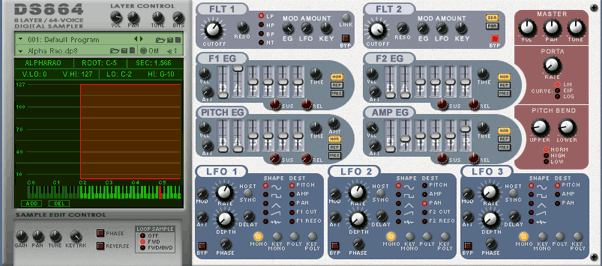
DS864 Digital Sampler
|
|

|
Next, we'll create a 'keyboard split' on the keyboard by assigning only the lower half to trigger the bass. To do this, use the 'Note Filter' on the top right of the Syn.Ops view. Set the note range to C4 through C5 (default is C0 through G10). Now playing the left side of your MIDI keyboard will trigger DS864, the right side will not..
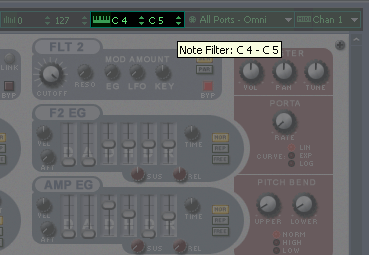
The Note Filter in Syn.Ops
|
|

|
Depending on where Middle C falls on your keyboard, the register of the bass might be a little high. To get a nice, round and realistic sound, you may need to transpose the instrument down. You can transpose the instruments response up or down in steps by clicking and dragging on the transpose up/down arrows at the top of Syn.Ops. In this case we'll set DS864 to play an octave lower than the keys on the keyboard.

Syn.Ops allows you transpose an instrument up or down by semi-tones
|
|

|
Now, add an instance of PSYN and load up an organ sound using the patch 'Vintage Section 4' from Bank A. Here, we'll do the opposite of step 3, instead setting the patch to only play when we hit a Db5 or above.

Configure PSYN to only respond to the upper region of the keyboard
|
|

|
 Creating Velocity Layers Creating Velocity Layers
In addition to grouping instruments using keyboard splits, we can layer them on top of each other. We can control the mix between these layers, simply by how hard we play the keyboard. Layering multiple sounds can really open up new possibilities, whether it's thickening up a bass part, adding punch to a kick drum, or adding texture to a pad. Let's add another instance of DS864, this time using the Alpha Rao patch from the Dream Experience (Found on Disk 1 of Project5). Lower the instrument's volume to about 40%. Now try playing a chord anywhere above C5. Notice how the pad really adds urgency and depth to the organ? By using the note filter, you can also limit the response so that it only overlaps with the Organ.
|
|

|
Layering sounds can dramatically alter the dynamics of a piece, so it's nice to be able to turn the effect on and off. One way to do this is to use the 'Velocity Filter' in Syn.Ops. You can configure the instrument to be triggered whenever the note velocity falls within a certain range. If the range is 0 to 63, then the instrument will only trigger when the keyboard is played with little or medium velocity. If we set the range to be 64 to 127, then the sampler will be added into the mix only when we play the keyboard with vigor.

Velocity layers allow for greater dynamic expression
|
|

|
In addition to being able to trigger single notes from the keyboard, Project5 allows you to trigger entire musical phrases using either audio loops or sequenced data. This is done by using the SYNCHRON32 MFX plug-in or the Cyclone DXi plug-in.
Insert Velocity and load the AfroCuban kit. Next, insert SYNCHRON32 into the MFX bin. Double-click to open the user interface. Create a simple 16-step percussion pattern by painting out note triggers with the mouse.
.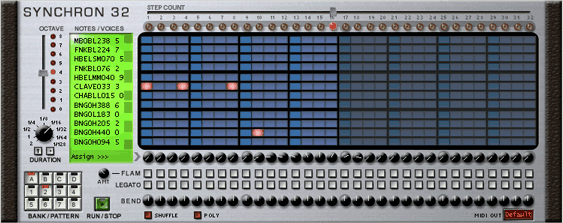
SYNCHRON32 allows you to graphically program instrument patterns
|
|

|
Next, right click on the note names and select the 'Lowest Trigger Note'. In this case, assign it to B3. Now playing B3 will trigger Pattern A1 in this instance of SYNCHRON32. C4 will trigger A2, C#4 will trigger A3, and so forth.
For a more complex arrangement, you can trigger multiple instances of SYCHRON32 on different instruments simultaneously. You can choose a common or independent trigger note for each instrument.
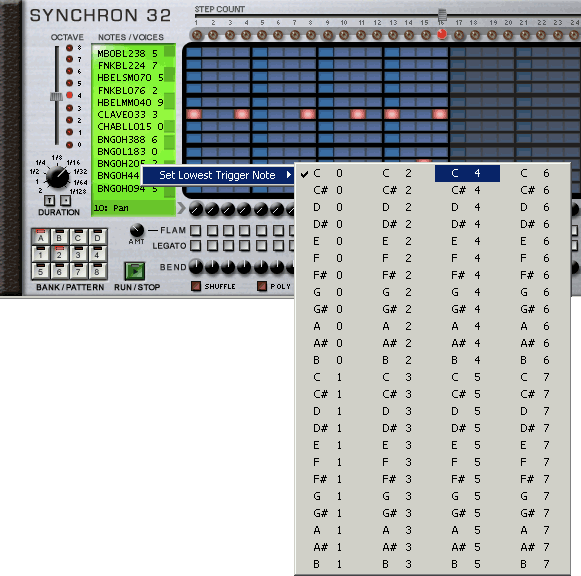
The assigned note will trigger pattern A1. Each half-step will trigger the next pattern up
|
|

|
If you are using ACIDTM-format .wav files or groove clips in your project, you can trigger these on the fly as well using Cyclone DXi.
Launch Cyclone DXi. Now click on the 'open' button in the Loop Bin. Select the Mad Funk 5 loop from the Smart Loops' Machine Kit (Found on Disk 1). Preview the loop then drag it to Pad 1. By default, each pad will play looped and in-sync with the project tempo when you click on it with the mouse.
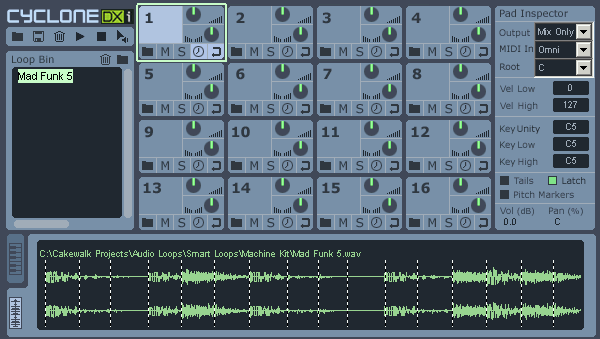
Cyclone DXi
|
|

|
Cyclone's keyboard view allows you to set which keys on your MIDI keyboard (or any MIDI controller) will trigger the assigned loop. Drag the markers above the 'High' and 'Low Key' to A3. Then drag the yellow 'Unity Note' to A3 as well. Using the latch function will allow a loop to continue playing even when you let go of the key. To turn off the loop, simply tap the key again.
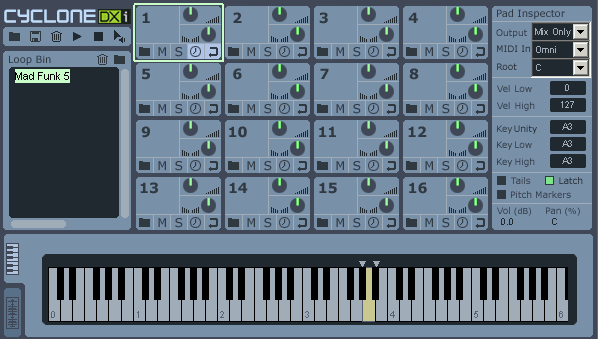
You can change the Key Unity and Keyboard Range by simply dragging and dropping the markers.
|
|

|
Each pad has its own volume and pan controls, as well as access to individual outputs, allowing different loops to be processed with different effects. This is just the tip of the iceberg with Cyclone, however. For an in-depth look at its possibilities, see this Cyclone Tech Tip.
|
|

|
 Real-time, All the Time Real-time, All the Time
Now that we've mapped out all of our instruments, it's time to get busy. You have no doubt noticed the proliferation of knobs, sliders, and buttons throughout Project5; tempting you to just reach out and twist, twiddle, and tweak to your heart's content. Project5 allows you to map any of these knobs to any MIDI keyboard, knob box, or digital mixer so that you can put every parameter right at your finger tips.
To begin, let's map one of PSYN's filters to a control on our keyboard. This could be a knob, foot pedal, or mod-wheel. The first step is to assign one of PSYN's parameters to one of the 8 knobs on the left side of Syn.Ops. Right-click a knob and select a parameter from the drop-down list. The 3rd menu option should let you choose from the Filter parameters, in this case, select 'Cutoff'.
|
|

|
Next, right-click the same knob and choose 'MIDI Remote Control'. Once the Remote Control screen appears, press 'Learn' and then move an assignable controller on your keyboard. If you don't have assignable knobs or faders, you can use an expression pedal or mod wheel. Project5 will automatically assign that controller to the currently selected parameter. You can also assign multiple controllers for each instrument or even different instruments. This means that even if you're working with DS864, you can still tweak PSYN directly from your hardware, without having to switch focus.
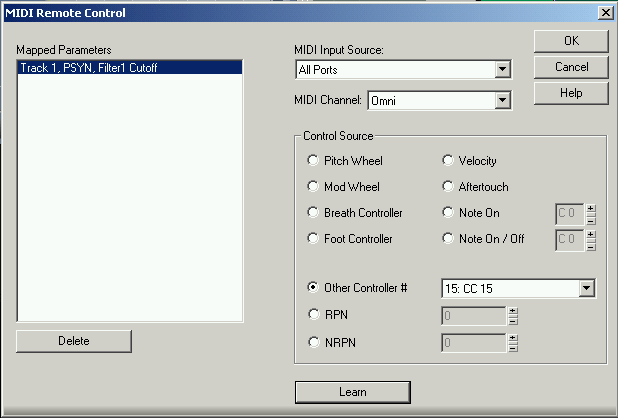
Project5's MIDI Remote Control screen lets you map hardware controllers to the software
|
|

|
We can perform a similar task with DirectX or VST effects as well. Select the Cyclone track and add the Project5 Classic Phaser by right-clicking in the Audio FX bin. To the immediate right of the FX bin you will see 4 assignable knobs mapped to various parameters of the phaser. To reassign a knob, simply right-click and choose another parameter. This way you can control the most frequently used settings quickly and easily without having to manage an additional user interface. (You can also double-click the effect name to see the full UI.)

Most commonly used parameters, right where you need them
Now, right-click the knob again and launch the MIDI Remote Control dialog to control the effect parameter with your keyboard or MIDI Device.
|
|

|
Of course, there are also plenty of other ways to control instruments, effects, and track parameters besides physically moving knobs and sliders. Select the PSYN track. Right-click on the Pan control for the track and choose MIDI Remote Control. Now, instead of pressing 'learn', select Velocity as a control source and press OK. Now, the strength with which you press the keys will directly control the stereo panning of the instrument. This technique also works great when controlling auxillary send levels, allowing you to effect the wet/dry mix of a track dynamically.
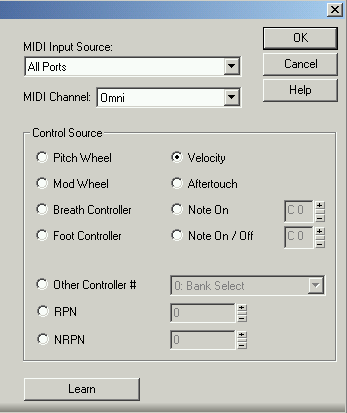
MIDI Remote Control can use many different Control Sources
|
| |
 From Stage to Studio and Everything in Between From Stage to Studio and Everything in Between
As you can tell, Project5 makes a seamless transition between the production environment and performance usage. Not only does Project5 give you the flexibility of software, but it gives you all the performance options of hardware, without the expense or weight of a workstation keyboard.
Equipped with this knowledge, you can control Project5 from any MIDI source; keyboards, MIDI guitars, or drum triggers. You can use this controller to play complete solos in real-time or to simply trigger loops on the fly, leaving you free for other tasks (like stage-diving off of the monitors).

TOP
|